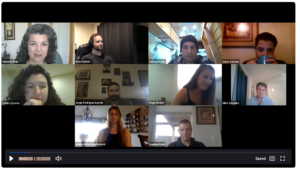
My dining room with chairs six feet apart, from middle of one chair to middle of next
Just a few days ago, the county where I live lifted the COVID-19 stay-at-home order, leading me to think more about what to expect with this pandemic as regards in-person meetings. My home state of Colorado is one of the earlier states to begin reopening. Currently, our governor’s orders are for offices to operate at up to 50% capacity–clearly not compatible with meetings of an entire department or work unit. In the best-case scenario, if there isn’t a huge surge in new infections, that order might get relaxed in perhaps a couple of months.
Even after offices are permitted to operate at full capacity, the responsible thing to do would be to have meeting participants sit six feet apart and wear masks. Have a look at the photos in these two links to get a sense of what that looks like.
I’d estimate only maybe five or six people would fit around a typical conference table; perhaps a dozen could fit in a good-size training room. I know from my facilitation experience that when people are so far apart physically, it feels cold and awkward–hardly a way to promote team cohesion. And what to do about employees at higher risk due to age or chronic health conditions? Exclude them, or put them in the awkward position of deciding whether to attend? I don’t see this scenario changing until everyone can get vaccinated, which means well over a year.
Happily, we have an alternative–videoconferencing, an option that would not have been so easily available had this pandemic occurred even 10 years ago.
I know, GROAN.
The term “Zoom fatigue” has entered our vocabulary, and for good reason (I can attest). Plus we all know you miss something when going from real, honest-to-goodness, in-person contact to something that transpires on a screen.

A recent online class
Hi Suzanne. Glad to receive and review your newsletter. I’ve linked into the IAF and we’re all figuring out how to continue with facilitation activities since face to face interaction is so important. I am getting some book sales – up to about 130 copies sold with some sales in Europe and Australia. The New Brunswick Association of Planers has asked me to prepare a course based on the book. Your work will always be noted. Cheers and be well. Dave Hardy
Thanks Dave! (I should probably re-join IAF.) For folks who don’t know, Dave Hardy’s excellent book (with my foreword) “Who Are These People and Why Are They Yelling at Me?” is here.